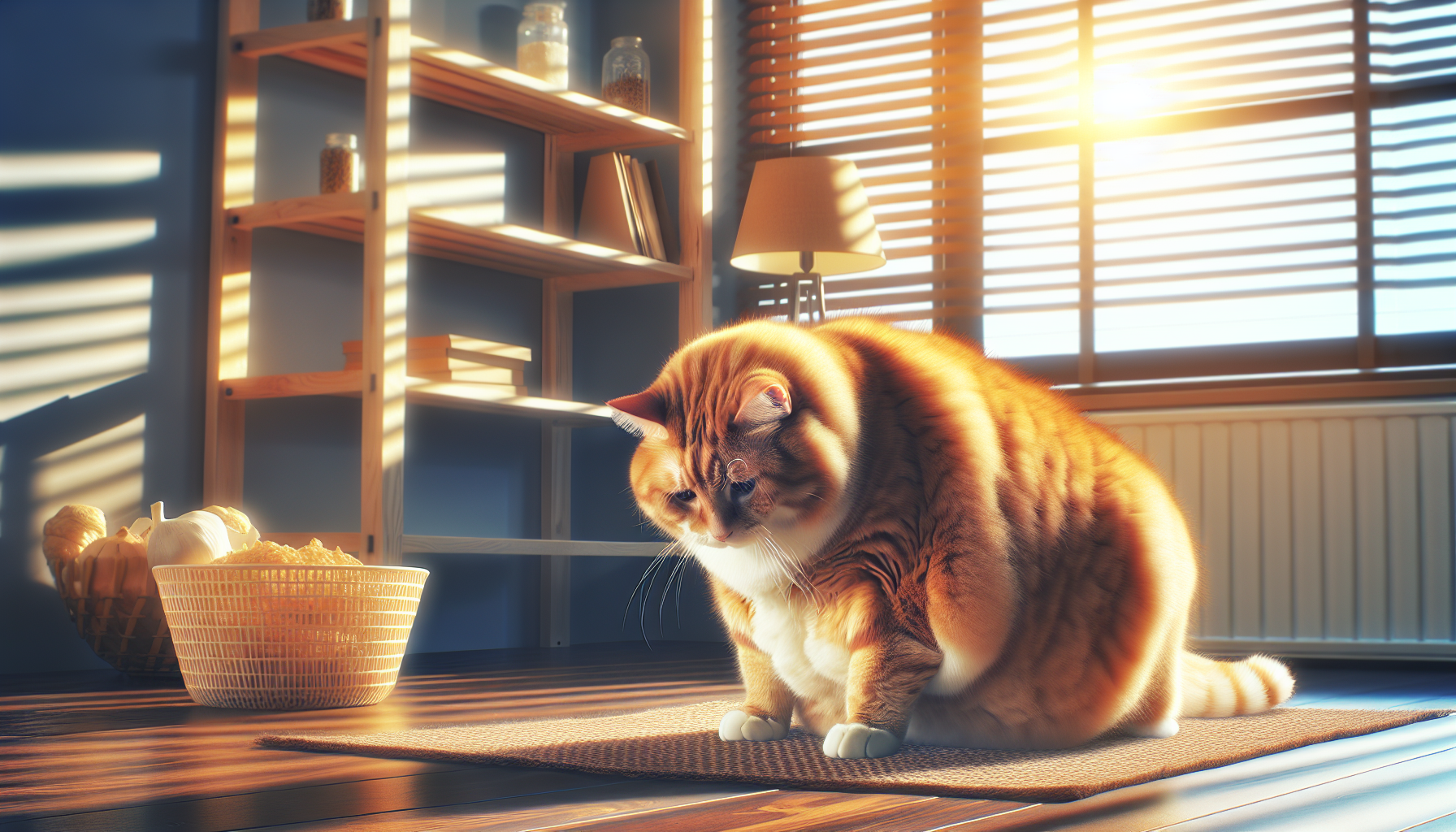Contents
Is your cat struggling with weight?
It’s no secret that obesity is a growing problem for both humans and their furry friends. If you’ve noticed that your cat is starting to become a bit too round around the edges, it may be time to take action. Just like humans, cats can experience a range of health issues due to excess weight, including diabetes, joint problems, and heart disease. In this article, we’ll explore some common signs that your cat may be overweight and provide some tips on how to help them shed those extra pounds.
Signs of cat obesity
1. Difficulty grooming: If your cat is struggling to clean certain areas of their body, such as the base of their tail or their hind legs, it may be a sign that they are carrying excess weight. Cats are naturally very clean animals, so if they are unable to groom themselves properly, it can be a clear indicator of obesity.
2. Inactive behavior: While cats are known for their love of lounging and napping, if your cat is consistently lethargic and shows little interest in play or movement, it may be a result of being overweight. Excess weight can put strain on their joints and make physical activity uncomfortable for them.
3. Difficulty breathing: If you notice your cat is panting or breathing heavily after minimal physical exertion, it could be a sign that their weight is impacting their respiratory system. This can be a serious issue and should be addressed with your veterinarian as soon as possible.
Helping your cat lose weight
1. Consult your veterinarian: Before making any significant changes to your cat’s diet or exercise routine, it’s important to consult with your veterinarian. They can assess your cat’s overall health and provide guidance on the best approach for weight loss.
2. Adjust their diet: Your veterinarian may recommend a specialized weight management cat food that is lower in calories and fat. Feeding your cat smaller, more frequent meals throughout the day can also help control their hunger and prevent overeating.
3. Increase physical activity: Encourage your cat to be more active by engaging in playtime with interactive toys or providing them with vertical spaces to climb and explore. Regular exercise can help burn calories and improve their overall fitness.
4. Monitor their progress: Keep track of your cat’s weight loss progress by regularly weighing them and taking note of any changes in their body shape. It’s important to be patient – weight loss should be gradual and sustainable for your cat’s wellbeing.
Remember, it’s important to approach your cat’s weight loss journey with patience and compassion. Rapid weight loss can have negative effects on their health, so it’s essential to work with your veterinarian to develop a safe and effective weight loss plan. With the right approach, you can help your cat achieve a healthy weight and improve their overall well-being.
Here’s how to help them lose it
Obesity has become a growing concern in today’s society, not only for humans but also for our beloved pets. Just like humans, pets need help to maintain a healthy weight. As a pet owner, it’s important to take this responsibility seriously and ensure that our furry friends are living their best lives. In this article, we will explore some effective ways to help our pets lose weight and improve their overall well-being.
1. Consult your veterinarian
Before embarking on any weight loss journey for your pet, it’s crucial to consult with your veterinarian. They will assess your pet’s current weight, overall health, and recommend a suitable weight loss plan. Each pet is unique, and their weight loss program should be tailored to their specific needs. Your veterinarian can provide guidance on proper nutrition, exercise routines, and any underlying health issues that may be contributing to their weight gain.
2. Monitor their diet
Just like humans, pets need balanced and nutritious meals to thrive. Avoid free-feeding and establish a consistent feeding schedule for your pet. Measure their food portions accurately to avoid overfeeding. Opt for high-quality, low-calorie pet food that is specifically formulated for weight management. Avoid feeding them table scraps or excessive treats, as this can contribute to weight gain. If you need guidance on choosing the right diet for your pet, consult your veterinarian.
3. Increase physical activity
Regular exercise is essential for pets to maintain a healthy weight. Dedicate time each day to engage your pet in physical activities such as walks, playtime, or interactive toys. The type and duration of exercise will depend on your pet’s breed, age, and overall health. Gradually increase the intensity and duration of their exercise routine to avoid overexertion. Engaging in physical activities not only helps your pet shed extra pounds but also strengthens their muscles and improves their overall well-being.
4. Keep them mentally stimulated
Pets, especially dogs, require mental stimulation to prevent boredom and emotional eating. Engage in interactive play sessions, provide puzzle toys, or even enroll them in training classes. Keeping their minds active will distract them from food cravings and help them maintain a healthier weight.
5. Stay consistent and patient
Weight loss takes time, so it’s essential to stay consistent and patient throughout the process. Regularly monitor your pet’s progress and make adjustments to their weight loss plan as needed. Celebrate small milestones and reward them with praise or a healthy treat. Remember, a gradual and sustained weight loss is healthier than rapid weight loss.
Helping your pet achieve a healthy weight is crucial for their overall well-being. By consulting your veterinarian, monitoring their diet, increasing physical activity, keeping them mentally stimulated, and remaining consistent and patient, you can effectively help your pet shed those extra pounds. Remember, your pet relies on you for their health, so be sure to provide them with the love and care they deserve. Let’s make their weight loss journey a successful and happy one!
By following these tips, you can help your pet achieve a healthier weight and improve their overall well-being. It’s important to remember that each pet is unique, so consult with your veterinarian for personalized guidance and support.
Proven diet tips for your cat
Owning a cat comes with great responsibility, and one of the most important aspects of caring for your feline friend is ensuring they have a healthy diet. Just like humans, cats require a balanced and nutritious diet to thrive. In this article, we will provide you with some proven diet tips to ensure your cat’s health and well-being.
1. Choose High-Quality Cat Food
The first and most crucial step in maintaining a healthy diet for your cat is to choose high-quality cat food. Look for brands that contain real meat as the primary ingredient, rather than fillers or by-products. Brands such as Royal Canin, Hills Science Diet, and Purina Pro Plan are known for their high-quality ingredients and balanced nutrition.
Additionally, check the label for essential nutrients such as protein, taurine, and fatty acids. These nutrients are essential for your cat’s overall health, including healthy skin, coat, and heart.
2. Regular Feeding Schedule
Establishing a regular feeding schedule for your cat is vital to maintain a healthy weight and prevent overeating. Cats should be fed small, frequent meals throughout the day rather than leaving food out all the time. This helps prevent obesity and encourages portion control.
Consult with your veterinarian to determine the appropriate amount of food to feed your cat based on their age, weight, and activity level. Each cat is unique and may have different dietary needs.
3. Avoid Human Foods
While it may be tempting to share your meal with your cat, it’s important to avoid feeding them human foods. Many common human foods are toxic to cats and can cause severe health issues. Foods such as chocolate, onions, garlic, grapes, and raisins should never be given to your cat.
If you want to treat your cat with something special, opt for cat-friendly treats or specific cat food formulated for treats. These options are designed to be safe and healthy for your feline friend.
4. Keep Hydration in Mind
Cats need to stay hydrated to maintain optimal health. Ensure that your cat always has access to fresh and clean water. Some cats prefer running water, so consider getting a cat water fountain to encourage them to drink more.
If you notice that your cat is not drinking enough water, you can add wet food to their diet. Wet food has a higher water content and can help prevent dehydration.
5. Monitor Weight and Adjust Portions
Regularly monitoring your cat’s weight is essential to ensure they are maintaining a healthy weight. Obesity can lead to various health problems, including diabetes and joint issues. Consult with your veterinarian to determine the ideal weight for your cat’s breed and age.
If you notice your cat is gaining or losing weight, adjust their portion sizes accordingly. Your vet can provide guidance on the appropriate amount of food and feeding frequency based on your cat’s specific needs.
By following these proven diet tips, you will ensure that your cat receives the nutrition they need for a long and healthy life. Remember to consult with your veterinarian for personalized advice based on your cat’s unique needs.
Take control of your cat’s weight with these strategies
As a responsible pet owner, it’s important to ensure that your cat maintains a healthy weight. Just like humans, overweight cats are more prone to various health problems such as diabetes, arthritis, and heart disease. By implementing these strategies, you can take control of your cat’s weight and help them live a long and happy life.
Evaluate your cat’s current weight
The first step in managing your cat’s weight is to evaluate their current weight. Consult with your veterinarian to determine if your cat is at a healthy weight or if they are overweight. They can provide you with a body condition score chart and help you interpret the results.
Tips:
- Weigh your cat regularly to track their progress.
- Look out for signs of excessive weight such as difficulty in grooming, mobility issues, or a lack of waistline.
Choose the right diet
Diet plays a crucial role in managing your cat’s weight. Look for high-quality, balanced cat food that is appropriate for their age and activity level. Opt for weight management or weight control formulas that are specifically designed for cats with weight issues.
Tips:
- Avoid free-feeding and establish a regular feeding schedule.
- Measure your cat’s food portions to ensure they are not overeating.
- Consider incorporating wet food into their diet as it can help increase hydration and promote weight loss.
Encourage exercise and playtime
Physical activity is essential for maintaining your cat’s weight. Engage your cat in interactive play sessions using toys that encourage them to move and jump. Schedule daily exercise sessions to ensure they get enough physical activity.
Tips:
- Set aside dedicated playtime every day.
- Rotate toys regularly to keep your cat engaged.
- Use treat-dispensing toys to make playtime more stimulating.
Monitor treats and snacks
Treats and snacks can easily contribute to weight gain in cats. While it’s important to reward your cat, be mindful of the number of treats you give them. Opt for low-calorie treats or use their regular food as treats during training sessions.
Tips:
- Limit treats to a small portion each day.
- Avoid giving table scraps or human food as treats.
- Include treats in your cat’s daily calorie intake to prevent overfeeding.
Consult with a veterinarian
If you’re struggling to manage your cat’s weight or have concerns about their health, it’s important to consult with a veterinarian. They can provide guidance and create a tailored weight management plan for your cat.
Tips:
- Ask your veterinarian about weight management diets and options.
- Discuss any health issues or concerns you have about your cat.
- Follow the veterinarian’s advice and recommendations for managing your cat’s weight.
By implementing these strategies, you can take control of your cat’s weight and help them lead a healthier and happier life. Remember, gradual weight loss is key, so be patient and consistent with your efforts. With your love and commitment, your cat can achieve and maintain a healthy weight.





